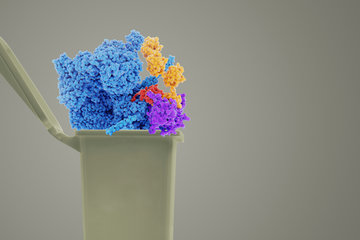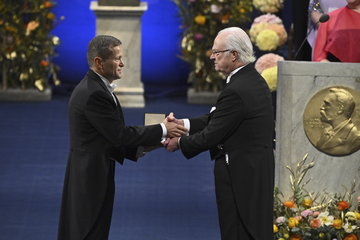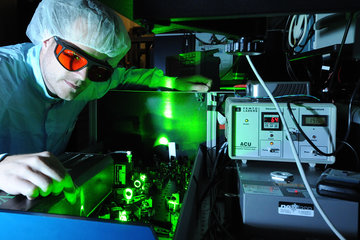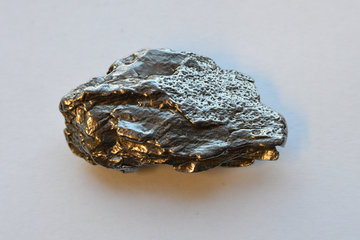Light microscopy provides a deep look into protein structure
An innovative fluorescence microscopy method makes it possible to image protein structures with a resolution of less than half an Angstrom
Light microscopy continues to reveal the microscopic world at an ever increasing resolution. Using a new method coined COLD, scientists at the Max Planck Institute for the Science of Light in Erlangen have now visualized protein structures with a resolution of around 5 Å. COLD achieves this unprecedented resolution by operating at a temperature of minus 270 degrees Celsius. At such low temperatures, the signals of fluorescent proteins can be localized more precisely. The method thereby opens up the possibility low temperatures, the signals of fluorescent proteins can be localized more precisely. The method thereby opens up the possibility of observing structural changes of proteins associated with specific diseases.

Until the end of the 20th century, light microscopes were subject to a major restriction: their resolution was limited by the wave nature of light. As early as 1873, the physicist Ernst Abbe formulated a law which, in simplified terms, states that an optical microscope cannot resolve structures measuring less than half the wavelength of visible light − around 200 nanometres. “This corresponds to a chain of several thousand atoms,” explains Vahid Sandoghdar, Director at the Max Planck Institute for the Science of Light.
This limit was regarded as insurmountable − until researchers developed super-resolution fluorescence microscopy methods, such as STED and PALM / STORM, within the past two decades. These techniques improved optical resolution to around only 20 to 30 nanometres. In 2014, the scientists involved in those invenstions, including Stefan Hell at the Max Planck Institute for Biophysical Chemistry in Göttingen, were awarded the Nobel Prize for Chemistry. Recently, a team headed by Hell increased the resolution limit by another twenty times with the help of a newly developed microscopy technique known as MINFLUX. The resolution of this method was sufficient to distinguish neighbouring molecules that are just a few nanometres apart.
COLD permits a glimpse into individual protein molecules
Vahid Sandoghdar and his colleagues have been working on alternative methods to increase the performance of high-resolution fluorescence microscopy for several years now − with considerable success, as the Erlangen physicist reports: “Our new approach allows us to display structures that are separated by a distance of less than five angstroms, i.e. half a nanometre. We are therefore able to look into protein molecules.” Sandoghdar and his colleagues presented the basic concept for the first time in 2013, which they have coined COLD for Cryogenic Optical Localization in Three Dimensions. The name COLD says it all: “The key thing about COLD is the low temperature at which the measurements take place, about minus 270 degrees Celsius,” says the physicist.
The basic principle of fluorescence imaging is the same for all microscopes: The sample is first chemically labelled with fluorescent molecules called fluorophores. This makes certain areas or components of the sample, e.g. cells, visible. However, conventional techniques are limited by the Abbe limit. Whenever several closely spaced fluorophores emit light simultaneously, their signals overlap and can no longer be recognized as separate points. The super-resolution methods, by contrast, are able to switch the fluorescent stain molecules on and off. This makes it possible to determine the position of each one with a relatively high degree of precision. However, the precision suffers from statistical noise: the more briefly the fluorophores emit light, the greater the imprecision. And usually they light up only for a very short time, because light-induced chemical processes bleach the molecule.
Molecules can be localized more precisely at low temperatures
This is where COLD comes into play. The extremely low temperatures slow down the photobleaching enormously so that each fluorophore lights up for a significantly longer time. “This reduces noise on the images and improves the localization accuracy,” states Siegfried Weisenburger, who performed the experiments as part of his doctoral research in Sandoghdar’s Department.
In collaboration with Christian Griesinger and his Department at the Max Planck Institute for Biophysical Chemistry in Göttingen, the Erlangen scientists were able to use their technique for resolving two fluorophores on a protein that were just one nanometre apart. At this scale, even the slightest vibrations and movements of the sample will ruin the experiment. “In order to measure atomic-scale distances, we had to develop a special, extremely stable cryogenic microscope,” Sandoghdar explains. “The samples are prepared by distributing the proteins in a thin polymer film on a glass slide.”
How are proteins arranged in a membrane?
In another experiment, the researchers demonstrated that COLD can be used to determine the spatial structure of proteins: They labelled a protein called streptavidin at four specific sites with fluorophores and recorded several hundred images. They then reconstructed the structure of the protein with the help of tomography algorithms. Ultimately, they achieved a three-dimensional resolution of about half a nanometre in locating the four dye molecules. “This resolution permits structure studies at the limit of other methods in structural biology.” This holds especially for Christian Griesinger’s field of research, NMR spectroscopy, which can only resolve distances below five angstroms. “COLD bridges the gap between fluorescence microscopy and structural biology,” says the Max Planck director in Göttingen.
The results are highly relevant to a number of scientists. “In cells, proteins change their structure to perform or alter their functions. Moreover, specific structural changes are often associated with specific diseases,” says Sandoghdar. In addition, COLD can determine the orientation of proteins. “Orientation is particularly interesting when you look with proteins in a membrane. That is the object of our current experiments,” explains Daniel Böning, a member of the research team in Erlangen.
Sandoghdar expects that the resolution of COLD can be improved further by a factor of ten. The technique would then operate at the atomic level. However, in that case it would come up against the intrinsic limit of fluorescence microscopy resulting from the size of the label molecules used. “COLD is ideal for visualizing proteins or smaller aggregates of biomolecules. On the other hand, due to the inhospitable temperatures, the technique can’t be used to investigate processes within living cells,” Sandoghdar summarizes. “At the moment, no microscopy method is able to observe everything. The various strategies must therefore continue to be used – as before and for the foreseeable future – in a complementary manner.”
JD












